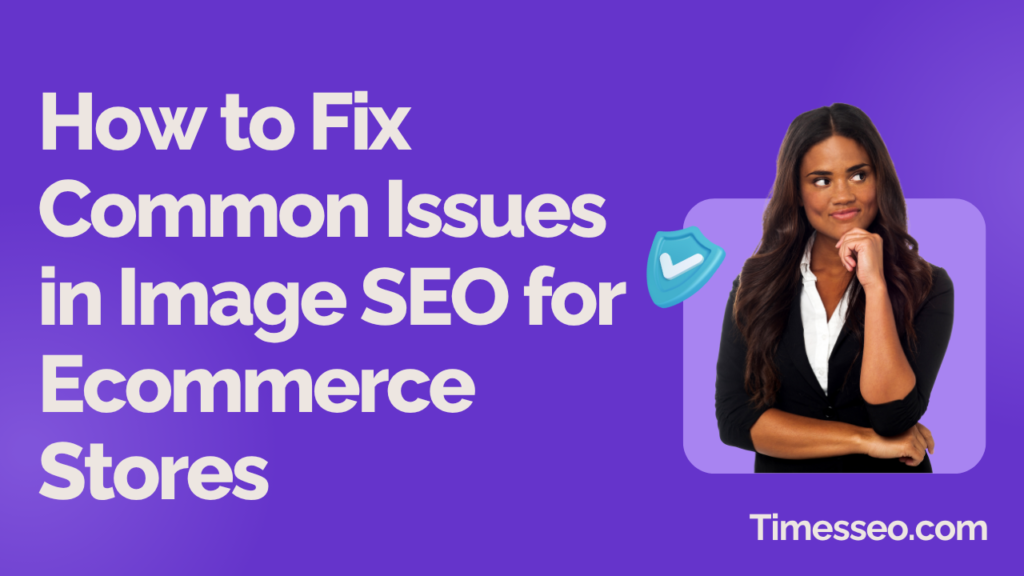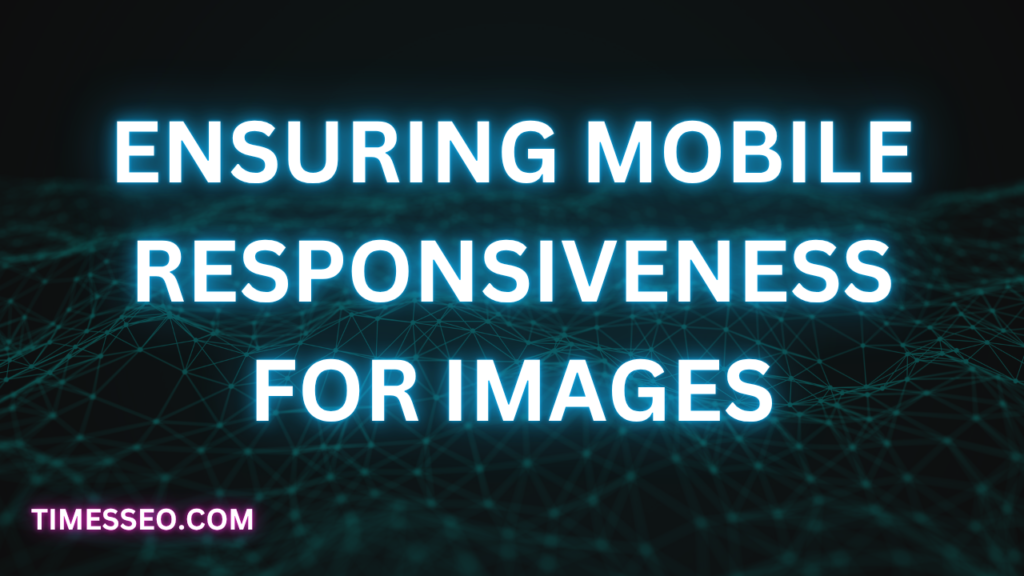
How to Fix Common Issues in Image SEO for Ecommerce Stores
Discover how to optimize your product images effectively in our latest blog post, “How to Fix Common Issues in Image SEO for Ecommerce Stores.” Learn how to tackle common problems like missing ALT tags, large image sizes, and unoptimized filenames to improve your site’s visibility and loading speed. This guide is perfect for ecommerce store owners looking to boost their rankings with better image SEO for ecommerce stores.
Table of Contents
Introduction
If you run an ecommerce store, you’re probably focused on product descriptions, pricing, and promotions—but what about your images? Believe it or not, image SEO can make or break your online visibility. Think of your product images as digital sales reps—they need to be sharp, searchable, and speedy.
When images aren’t optimized, your site loads slower, ranks lower, and delivers a poor experience for both search engines and shoppers. But the good news? These issues are totally fixable.
Let’s break down the most common image SEO problems in ecommerce—and show you exactly how to fix them.
Common Image SEO Issues in Ecommerce Stores
Missing or Poor Alt Text
Alt text is crucial for SEO and accessibility, yet many store owners skip it or write vague descriptions like “image1.jpg.” That’s a missed opportunity.
Large and Uncompressed Image Files
High-res images might look beautiful—but if they aren’t compressed, they drag down your site speed, frustrating both users and Google.
Non-Descriptive File Names
If your image is named DSC003948.jpg, Google has no idea what it is. Search engines can better comprehend your product images if you use descriptive filenames.
Slow Loading Product Galleries
Loading multiple unoptimized images at once? That’s a recipe for high bounce rates. Product galleries should be fast and smooth.
Lack of Mobile Optimization
Approximately half of all e-commerce traffic comes from mobile devices. Users will leave if your photos are not responsive, which can lower your results.
Duplicate Images Across Product Variants
Search engines become confused and your SEO value is diminished when you use the same image for different colors or models.
Ignored Image Sitemaps
If your image URLs aren’t in your sitemap, Google may not index them—meaning fewer chances to rank in image search.
How to Fix Missing or Poor Alt Text
Writing Descriptive and Keyword-Rich Alt Text
Alt text should describe the image and include your focus keywords naturally. Try “black leather ankle boots for women” in place of “shoe.”
Tools to Audit and Optimize Alt Text
To find missing or duplicate alt attributes, use SEO plugins like as Ahrefs, Yoast, or Screaming Frog. Fix them page by page.
How to Compress Large Image Files Without Losing Quality
Image Compression Tools and Techniques
Use tools like:
- TinyPNG
- ShortPixel
- Squoosh
- ImageOptim
These maintain quality while significantly reducing file size.
Choosing the Right File Format
- JPEG – Best for photos.
- PNG – Use for graphics with transparency.
- WebP: A modern format that strikes a balance between size and quality.
Renaming Images with Descriptive File Names
Best Practices for Naming Ecommerce Images
Use lowercase, hyphen-separated names with relevant keywords. For example: red-running-shoes-mens.jpg
File Naming Examples for SEO
Bad: IMG1234.jpg
Good: womens-summer-floral-dress.jpg
Speeding Up Product Galleries
Lazy Loading Techniques
To use slow loading, add loading=”lazy” to your image element. Images are only loaded when they are in the user’s field of vision.
Using CDN for Faster Image Delivery
A Content Delivery Network (CDN) stores your images in data centers around the globe, speeding up load times for users everywhere.
Popular CDNs:
- Cloudflare
- BunnyCDN
- Amazon CloudFront
Ensuring Mobile Responsiveness for Images
Implementing Responsive Image Tags
Use the srcset and sizes attributes to deliver the most appropriate image version based on the user’s screen size.
Testing Mobile Image Performance
To identify and address problems, use Chrome DevTools’ Lighthouse and Google’s Mobile-Friendly Test.
Dealing with Duplicate Product Images
Creating Unique Angles and Shots
Showcase different perspectives, lifestyle shots, or packaging for each product variant to add visual diversity.
Differentiating Image Content Across Variants
If you’re selling a red and blue version of a product, show both colors separately to avoid duplication penalties.
Submitting and Maintaining an Image Sitemap
Creating Image Sitemaps with Plugins or Tools
Use tools like:
- Rank Math
- Yoast SEO
- Screaming Frog
These can generate and update image sitemaps automatically.
Submitting to Google Search Console
Navigate to Sitemaps > Enter your image sitemap URL > Submit.
This helps Google index all your visual content faster.
Monitoring and Improving Image SEO Continuously
Tools for Tracking Image Performance
- Google Search Console (check “Image” under performance)
- Ahrefs/Semrush (track keyword rankings for image-rich pages)
Setting Up Alerts and SEO Health Checks
Set periodic audits using tools like SEMrush Site Audit or Ahrefs Site Health to catch issues early.
Conclusion
Fixing image SEO issues isn’t just a “nice to have”—it’s a must-do for every ecommerce store aiming for top rankings and conversions. From proper alt text to lightning-fast load times and mobile-ready visuals, each fix you make boosts your SEO strength and improves user experience.
Treat your images like silent salespeople—they need to be clear, fast, and informative. Now that you know what’s broken and how to fix it, your ecommerce store is already a step ahead of the competition.
Frequently Asked Questions
Every 3 to 6 months, or whenever you upload a significant batch of new product images.
Yes! WebP reduces file size while maintaining quality, which improves load time—a key SEO factor.
It's better to use original product photos. Stock images can harm trust and aren’t unique for SEO purposes.
Absolutely. Captions are often read and indexed—especially if placed near keywords and product context.
Your site may suffer from slower loading times, poor rankings in Google Images, and reduced organic traffic—directly impacting sales.
Table of Contents
Popular Posts
-
 Affordable Technical SEO Audit for Small Business: A Complete Guide26 Jun 2025 Blog
Affordable Technical SEO Audit for Small Business: A Complete Guide26 Jun 2025 Blog -
 How to Get an Affordable Technical SEO Audit for Small Business27 Jun 2025 Blog
How to Get an Affordable Technical SEO Audit for Small Business27 Jun 2025 Blog -
 The Ultimate Local SEO Audit Checklist for Startups28 Jun 2025 Blog
The Ultimate Local SEO Audit Checklist for Startups28 Jun 2025 Blog -
 Local SEO Audit Checklist for Startups: A Beginner’s Guide28 Jun 2025 Blog
Local SEO Audit Checklist for Startups: A Beginner’s Guide28 Jun 2025 Blog -
 Top On-Page SEO Audit Steps for Service Websites Every Business Should Know29 Jun 2025 Blog
Top On-Page SEO Audit Steps for Service Websites Every Business Should Know29 Jun 2025 Blog -
 Technical SEO for WordPress: The Ultimate Beginner’s Guide01 Jul 2025 Blog
Technical SEO for WordPress: The Ultimate Beginner’s Guide01 Jul 2025 Blog -
 The Impact of On-Page SEO Audit Steps for Service Websites on UX01 Jul 2025 Blog
The Impact of On-Page SEO Audit Steps for Service Websites on UX01 Jul 2025 Blog -
 Technical Mobile SEO Audit Tips for Developers02 Jul 2025 Blog
Technical Mobile SEO Audit Tips for Developers02 Jul 2025 Blog -
 Complete SEO Backlink Audit Guide for Better Google Rankings03 Jul 2025 Blog
Complete SEO Backlink Audit Guide for Better Google Rankings03 Jul 2025 Blog -
 Boost Your Rankings with Technical SEO for WordPress01 Jul 2025 Blog
Boost Your Rankings with Technical SEO for WordPress01 Jul 2025 Blog






